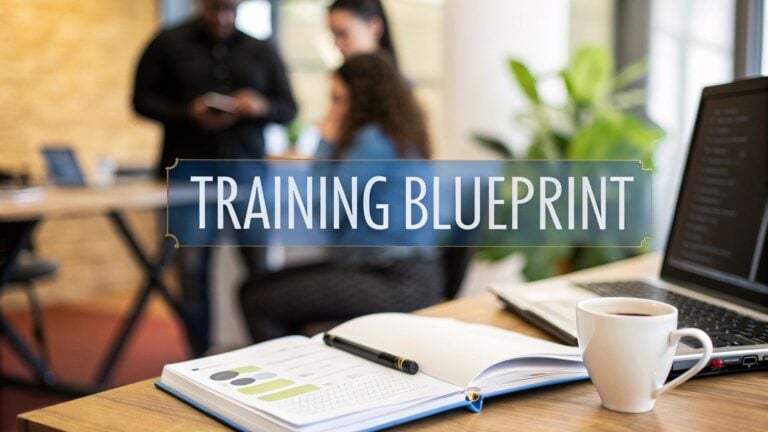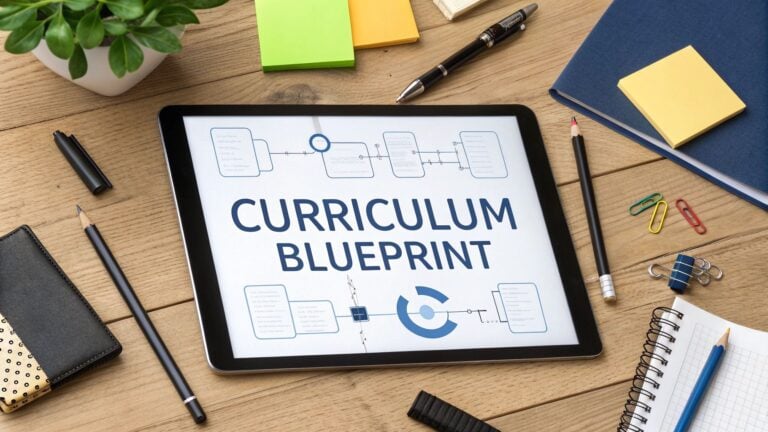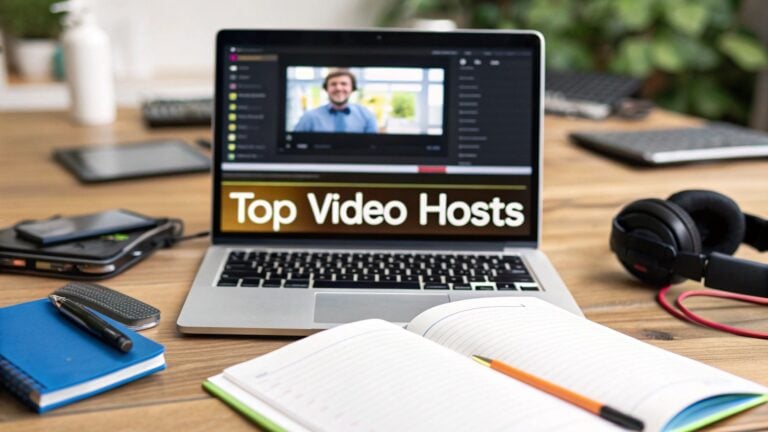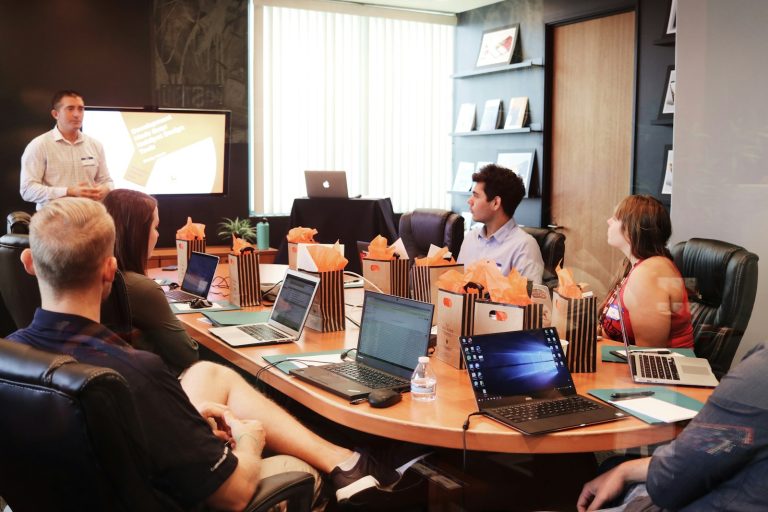A Practical Guide to Learning Styles in Adults
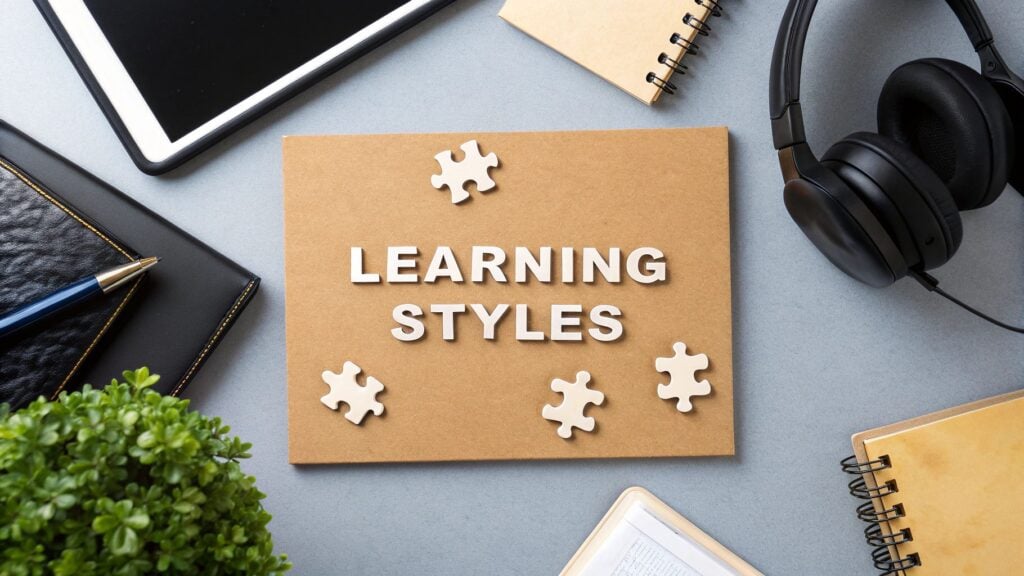
Ever wonder why some new skills just click while others feel like an uphill battle? The answer often has less to do with the topic and more to do with how you’re trying to learn it.
I wrote this guide to be all about adult learning styles and, more importantly, how a little bit of insight can make a massive difference in how you teach, train, and learn.
Why Understanding Adult Learning Styles Matters
Let’s unpack what “learning styles” really means for adults. Forget the dry, academic theories for a moment. Think of this as a practical tool that can improve everything from a mandatory company training session to the online course you’re building in your spare time.
Recognizing these different approaches is a complete game-changer. It makes learning more effective, sticky, and genuinely more enjoyable for everyone. For me, it was the key to finally understanding why I struggled through certain subjects but flew through others.
The truth is, adults don’t learn like children. We show up with a lifetime of experience, opinions, and habits. We’re also driven by specific goals. We want to see the immediate relevance of what we’re learning and how it solves a real problem we’re facing right now.
A core principle in adult education, known as andragogy, is that adults are self-directed. We learn best when we understand the “why” behind the information and can connect it directly to our own lives and challenges.
This is exactly why a one-size-fits-all approach so often falls flat in corporate training or online courses. It ignores the fundamental nature of how we, as adults, actually process new information.
Making Learning More Inclusive
When you design any kind of learning experience, acknowledging different preferences is the first step toward creating something that actually works. It helps you build a more inclusive and flexible environment where more people have a real shot at success.
This is especially critical today. The OECD’s 2023 Survey of Adult Skills revealed that participation in adult learning has stagnated, with only about 50% of adults taking part in any formal or non-formal education.
This tells us we have a huge opportunity to make learning more accessible and responsive to how people actually want to engage. You can dig into the full story in the OECD’s adult learning trends report.
By getting a handle on these styles, you can finally answer questions like:
- Why does one person on my team thrive with video tutorials while another begs for a detailed manual?
- How can a single online course engage both the person who learns by doing and the person who learns by listening?
- What small tweaks can I make to my own study habits to finally make new information stick?
Answering these questions is how we move beyond just dumping information on people and start creating opportunities for genuine understanding and skill development that lasts.
Exploring the Most Popular Learning Models
So, how do we start to make sense of all these different learning preferences? Over the years, experts have come up with several models to help us categorize the different ways adults take in and process information.
While there are a bunch of them out there, I want to focus on the one that’s arguably the most practical for everyday use.
I’m talking about the VARK model. It’s an acronym that stands for Visual, Aural, Read/Write, and Kinesthetic. It’s become so popular because it gives us a simple, yet powerful, framework for thinking about learning styles without needing a PhD in cognitive psychology.
Breaking Down the VARK Model
At its core, the VARK model suggests that most of us have a preferred way, or a few preferred ways, of absorbing new information. This helps us understand our own natural tendencies so we can play to our strengths, both as learners and as educators.
So what do these styles actually look like in the real world?
Visual Learners: These are the people who need to see it to get it. They connect with charts, diagrams, mind maps, and well-designed videos. A visual learner in a team meeting will get way more from a clear slide deck than from a long, rambling speech.
Aural (Auditory) Learners: They learn best by hearing. Think podcasts, lectures, group discussions, and audiobooks. This is the person who can recall everything their manager said in a meeting, word-for-word, even without taking notes.
Read/Write Learners: Give them the manual! These folks prefer to interact with the written word. They love diving into detailed reports, making lists, and taking extensive notes to help information sink in.
Kinesthetic Learners: This is all about learning by doing. Kinesthetic learners need a hands-on experience to make sense of things. They’re the ones who would rather assemble that IKEA furniture through trial and error than sit down and read the instructions first.
To make this even clearer, here’s a quick breakdown of how each style prefers to learn.
The Four VARK Learning Styles Explained
| Learning Style | What It Means | Best Way to Learn |
|---|---|---|
| Visual | Prefers seeing information through images, charts, and diagrams. | Infographics, videos, flowcharts, and mind maps. |
| Aural | Prefers hearing information through lectures, discussions, and sounds. | Group discussions, podcasts, audio recordings, and storytelling. |
| Read/Write | Prefers interacting with text by reading and writing. | Written instructions, manuals, taking notes, and reading articles. |
| Kinesthetic | Prefers learning through physical experience and hands-on practice. | Simulations, role-playing, building models, and real-world projects. |
This table gives you a snapshot, but it’s important to remember that these styles are more like shades of preference than concrete types. This infographic helps visualize how each style is just a different pathway for information to travel.
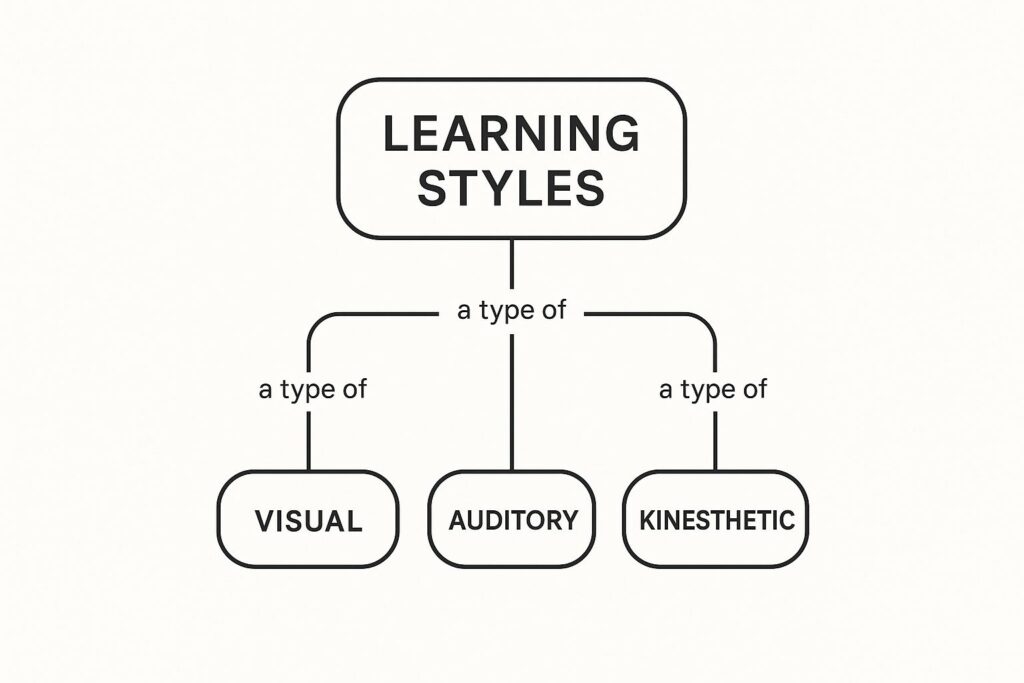
Each branch represents a distinct way of processing the world, but they all stem from the same core need to learn and understand.
The Reality of Multimodal Learning
Now, here’s the really important part. While it’s helpful to understand each style, very few people fit neatly into a single box. The truth is, most of us are a blend of two, three, or even all four. This is what’s known as having multimodal preferences.
The research backs this up completely. One study found that about 61% of adult learners have multimodal preferences. For the 39% who did lean heavily toward one mode, the kinesthetic (learning by doing) style was the most common. You can dive deeper into these numbers in this fascinating study on VARK preferences.
What this means is that even if you’re a die-hard visual learner, you still get value from a good group discussion or a hands-on activity. It’s about having a primary preference, not an exclusive one.
The key takeaway is that truly effective learning often involves engaging multiple senses. The more ways you can interact with information, such as seeing it, hearing it, and doing something with it, the more likely it is to stick.
A Quick Look at Other Models
While VARK is incredibly practical, it’s not the only game in town. Another well-known framework is Kolb’s Experiential Learning Cycle. This model focuses on a four-stage cycle of learning from experience.
It breaks down like this:
- Concrete Experience: You have a new experience or just do something.
- Reflective Observation: You step back and reflect on that experience and what it meant.
- Abstract Conceptualization: You form new ideas or adjust your thinking based on that reflection.
- Active Experimentation: You apply your new ideas to the world around you, which kicks off a whole new cycle of experiences.
Kolb’s model is a great reminder that deep understanding comes from trying things out, seeing what happens, and thinking about the results. These frameworks are foundational concepts in creating effective learning environments. To see how these ideas plug into a bigger strategy, you might be interested in our guide on instructional design models for e-learning.
Ultimately, understanding these models gives us a shared language to talk about how we learn. They provide a fantastic starting point for designing better training and becoming more self-aware learners ourselves.
The Great Debate on Learning Styles
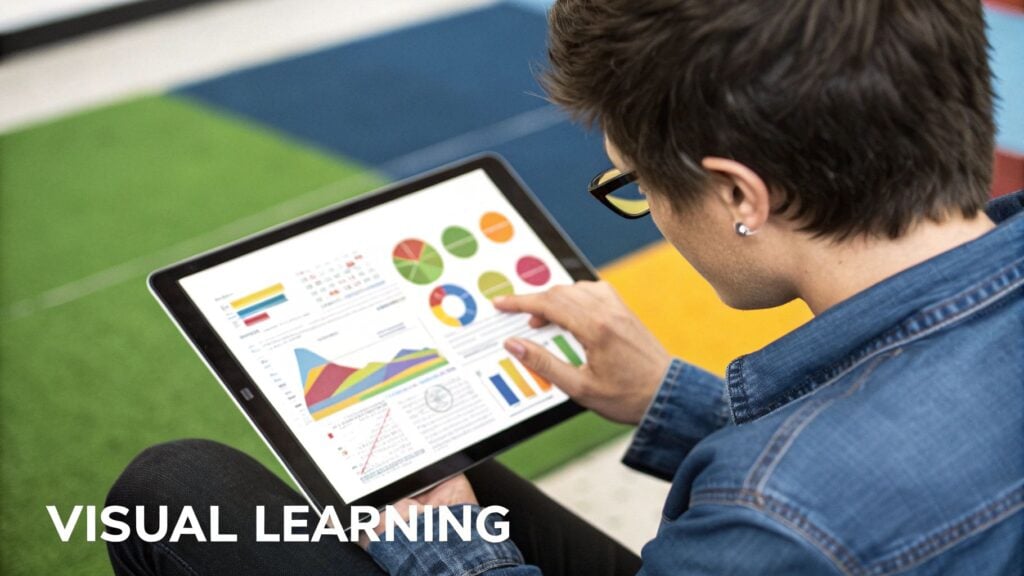
Alright, let’s tackle the elephant in the room. If you’ve spent any time at all researching adult learning, you’ve almost certainly stumbled across articles calling the whole concept of learning styles a myth. So, what’s the real story? Did you just read all this for nothing?
Absolutely not. But it’s crucial to understand what the critics are actually saying.
When researchers push back against “learning styles,” they’re targeting a very specific, rigid interpretation of the idea. Their main point is that there’s very little hard evidence showing that matching a teaching method to a person’s self-diagnosed “style” actually improves their test scores.
And they have a point. The criticism is completely valid when you treat a learning style like a fixed personality trait, like being an introvert or an extrovert. The research simply doesn’t back up the notion that a “visual learner” is incapable of learning from a podcast, or that a “kinesthetic learner” is doomed to fail if they have to read a book.
Shifting from Styles to Preferences
This is where a simple change in language makes all the difference. I’ve found it’s far more useful to think in terms of flexible learning preferences rather than rigid learning styles. A preference is just a tendency, a way you lean. It doesn’t define you or put you in a box.
For example, my personal preference for learning new software is to watch a video tutorial. It’s my go-to starting point because it feels faster and more engaging for me. But that doesn’t mean I can’t learn by reading the user manual. I can, and sometimes I have to.
Thinking about “preferences” frees us from the trap of labels. It encourages us to recognize our natural tendencies without letting them become excuses for avoiding other ways of learning. This is the key to a balanced and effective approach.
So, if the science is so shaky, why has the idea of learning styles stuck around? Because on a purely practical, human level, it just clicks. We all know from our own lives that some ways of learning just feel easier or more natural. The concept gives us a language to talk about those very real differences.
Why Preferences Still Matter a Lot
Even if knowing your preference doesn’t magically boost your test scores, understanding it is a powerful tool for making learning more enjoyable and effective. When you know what works for you, you can take the driver’s seat in your own learning journey.
Here’s why focusing on your preferences is still a brilliant strategy:
- It Boosts Engagement: When you learn in a way you genuinely enjoy, you’re far more likely to stick with it. An interactive workshop will hold the attention of a hands-on person for hours longer than a dry lecture. It’s just common sense.
- It Builds Confidence: Starting with your preferred methods can help you get your footing with a new topic. That initial success is what builds the confidence you need to tackle more challenging formats later on.
- It Encourages Metacognition: The simple act of thinking about how you learn is incredibly valuable. It turns you into a more self-aware, strategic learner, which is one of the most critical skills any adult can possess.
The goal was never to find your one true style and stick with it for life. The real value is in recognizing where you like to start, and then intentionally mixing in other methods to build a more well-rounded understanding.
True Mastery
True mastery often comes from seeing a topic from multiple angles. This is a core idea behind many modern learning approaches, and you can see how it plays out in our guide on discovery-based learning and why we learn by doing.
Ultimately, the debate is about taking a practical, balanced view. We can acknowledge the scientific criticism while still using the core ideas to make our learning experiences richer and more effective.
Alright, we’ve waded through the models and even touched on the debates surrounding them. Now for the fun part: turning all that theory into action. Knowing about learning styles is interesting, but the real win is using that knowledge to your advantage.
Think of this as your personal toolkit, a set of strategies you can pull out in any learning situation. Whether you’re studying for a new certification or just picking up a hobby, getting a handle on your learning tendencies can make the whole process smoother and way more enjoyable.
A Quick Self-Assessment Guide
You don’t need some complex, 50-question quiz to get a feel for your go-to learning methods. The best place to start is with a little honest self-reflection.
Just think about the last time you had to learn something new and genuinely challenging. What was your first instinct? Your honest answers here are the best clues you’ll get.
When you get a new gadget, do you:
- A) Watch a video review or tutorial to see it in action? (Visual)
- B) Chat with a friend who already has one to get their take? (Aural)
- C) Read the instruction manual from cover to cover? (Read/Write)
- D) Just start pushing buttons and figure it out as you go? (Kinesthetic)
If you need to remember a new phone number, do you:
- A) Picture the numbers in your head or on a keypad? (Visual)
- B) Say the numbers out loud to yourself a few times? (Aural)
- C) Jot the number down on a piece of paper? (Read/Write)
- D) Trace the numbers with your finger on a table or in the air? (Kinesthetic)
Just by answering those two questions, you probably have a gut feeling about which letters you gravitated towards. Most of us are a mix, of course, but there’s usually one or two that just feel more natural.
Putting Your Preferences into Practice
Once you have an idea of your natural inclinations, you can start being intentional about how you tackle new topics. This is where you can make a huge difference in how quickly and deeply you learn.
The goal isn’t to only use your preferred methods. It’s about starting with them to build confidence and understanding, then layering in other approaches to round out your skills.
Here are some practical strategies you can use, broken down by preference:
For Visual Learners
If you realized you’re a visual learner, your mission is to turn information into something you can see.
- Create mind maps to connect ideas visually instead of just writing linear notes.
- Use color-coding with highlighters to organize your notes by theme or importance. It’s not just about making things pretty, it’s about creating a visual system.
- Seek out video tutorials, documentaries, and infographics as your first stop when learning something new.
- Draw diagrams and charts to map out processes or complex relationships. Even a rough sketch can clarify a concept better than a page of text.
For Aural Learners
If you connect with sound, you need to find ways to hear the information you’re learning.
- Record lectures or meetings so you can listen back to them. You’ll often catch things you missed the first time.
- Talk it out. Try to explain a new concept out loud to someone else, or even just to yourself. The act of verbalizing clarifies your own thinking.
- Find relevant podcasts or audiobooks to supplement your reading materials.
- Jump into group discussions. Hearing different perspectives and articulating your own thoughts is a powerful learning tool.
A key insight for aural learners is that speaking is just as important as listening. Teaching a concept to someone else is one of the fastest ways to lock it into your own memory.
For Read/Write Learners
If you learn best through text, you should lean into that strength. Your power is in the written word.
- Take detailed, well-organized notes during any learning session. The process of writing itself helps with retention.
- Rewrite key concepts in your own words. This simple act forces your brain to process the information on a deeper level.
- Create lists, summaries, and cheat sheets to distill large amounts of information into something more manageable.
- Dive deep into articles, reports, and books to get a thorough understanding of a topic.
For Kinesthetic Learners
For you, learning isn’t a spectator sport. It’s an active process. You need to get your hands dirty.
- Find ways to apply what you’re learning immediately. If you’re learning new software, don’t just watch a tutorial, start a small project with it.
- Use simulations or role-playing to practice real-world scenarios in a safe environment.
- Take frequent breaks to stand up and move around, especially during long study sessions. A little physical activity can reset your focus.
- Build a physical model or use flashcards that you can physically manipulate. The connection between hand and brain is powerful for you.
By strategically using these methods, you’re not just studying harder. You’re studying smarter by aligning your activities with the way your brain is already wired to work.
Designing Courses for Every Adult Learner
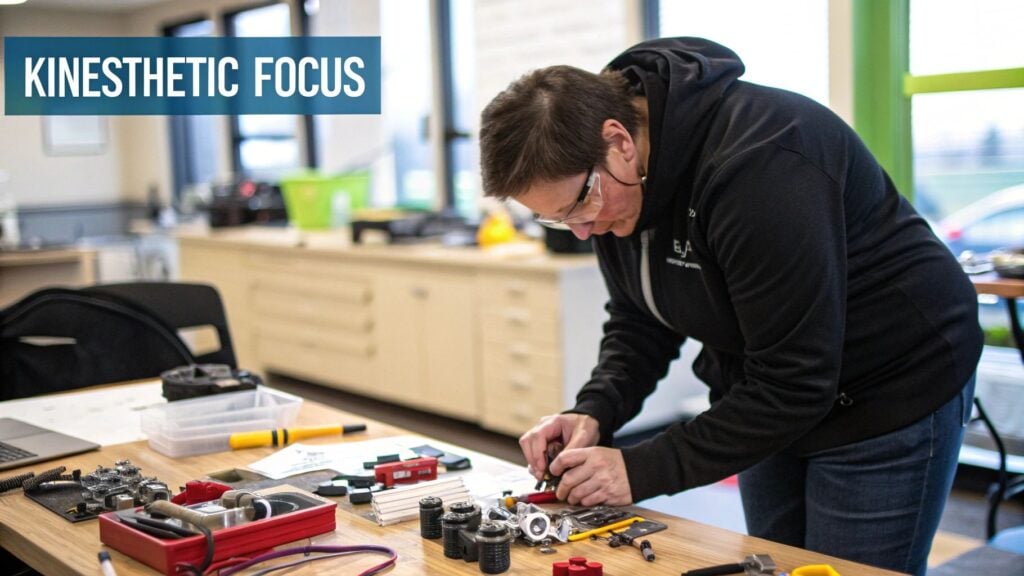
If you’re a course creator, educator, or trainer, you know the struggle. How do you design a single learning experience that connects with a whole room full of adults, each with their own way of soaking up information?
The answer is to stop trying to teach to one specific “style.” Instead, the real key is to embrace multimodal design.
It’s just a practical way of saying you should blend different formats and activities to engage everyone, no matter how they learn best. I’ve found this approach to be a complete game-changer in my own work.
Building a Multimodal Learning Experience
Think of yourself as a chef creating a buffet. A single dish won’t satisfy every guest, but a spread with a variety of options ensures everyone leaves happy. The same principle applies when you’re designing courses.
Your goal is to offer multiple ways for learners to interact with the material. This respects the different ways adults process information and, more importantly, makes your content far more engaging for your entire audience.
Here’s how you can start blending formats to hit all the right notes:
For Visual and Aural Learners: Video lectures are a classic for a reason. They combine visual cues (slides, speaker’s expressions) with spoken explanations. A well-produced video is powerful, and a good guide to making effective tutorial videos can show you how to nail the delivery every time.
For Read/Write Learners: These learners crave text. You can support them with downloadable guides, detailed transcripts of your videos, and links to articles for deeper dives. A well-written workbook can be their best friend.
For Kinesthetic Learners: This group needs to get their hands dirty. Interactive simulations, real-world case studies they can pull apart, and hands-on projects are essential. Don’t underestimate the power of a simple worksheet. It gives them something tangible to do.
This isn’t just a nice-to-have. It’s a response to a booming market. The global adult education sector is projected to grow at 7.5% annually between 2023 and 2030, with online platforms leading the charge because they offer the flexibility adults need.
Small Changes That Make a Big Difference
You don’t have to completely tear down your existing courses to make this work. Often, just a few small tweaks can dramatically boost how much your students engage with and remember your content.
I’ve seen firsthand how adding a single hands-on project to a lecture-heavy course can transform the entire experience. Suddenly, learners are applying concepts, asking smarter questions, and connecting with the material on a completely different level.
Powerful learning environments offer multiple pathways to the same destination. This allows learners to choose the route that works best for them.
Multimodal Course Design Checklist
To help you put this into practice, I’ve put together a simple checklist. Use this as a guide when you’re building or updating your next course to make sure you have something for everyone.
| Learning Preference | Content Element to Include | Example Activity |
|---|---|---|
| Visual | Charts, diagrams, and infographics. | Create a mind map summarizing the key concepts of a module. |
| Aural | Podcasts or audio recordings. | Host a live Q&A session where learners can ask questions and discuss topics. |
| Read/Write | Detailed manuals or written guides. | Provide a downloadable PDF checklist that recaps the main action steps. |
| Kinesthetic | Hands-on projects or simulations. | Design a role-playing exercise where learners apply a new skill. |
By thoughtfully weaving these elements together, you create a richer, more flexible learning environment. For more ideas on bringing this to life, check out our guide on interactive learning design ideas for inspiration. This approach respects the diversity of your learners and, ultimately, makes your teaching far more effective.
So, What Do We Do With All This?
We’ve journeyed through classic learning models and dug into some real-world tips for both learners and the people designing their courses. But what happens now? It’s time to connect the dots and turn all this theory into a practical path forward.
If you remember just one thing from our time together, let it be this: focus on flexible preferences over rigid styles. The game isn’t about discovering your one “true” learning style and sticking to it for life. It’s about building a mental toolkit full of different methods you can pull out depending on the situation.
Think of it as your personal game plan for becoming a ridiculously effective learner. The best part? This journey never really ends, which is what makes it so rewarding.
Your Personal Action Plan
Honestly, understanding how you learn best is one of the most powerful skills you can build. It flips learning from something that just happens to you into something you do with intention and purpose.
Here’s how you can keep that momentum going:
Play detective: Start paying close attention to what actually works for you. When you’re in the zone and things are just clicking, pause and ask why. Was it the hands-on project? The group brainstorming session? That one video that explained it perfectly?
Mix it up on purpose: Get comfortable with being a little uncomfortable. If you’re a bookworm who loves to read, challenge yourself to watch a documentary on the topic instead. If you always jump straight into doing, try reading a detailed guide first.
Stay curious: The goal here isn’t to find a final answer and slap a label on yourself. Your preferences might change from subject to subject, and that’s perfectly fine.
The real secret to powerful adult learning is self-awareness. Knowing your go-to strengths helps you lean on them, and knowing your default tendencies lets you consciously build a more balanced approach.
This mindset is the absolute core of lifelong learning. It’s all about staying curious, adaptable, and in the driver’s seat of your own growth. So go ahead, keep exploring, keep experimenting, and most importantly, enjoy the process.
Wrapping Up: Your Top Questions Answered
As we get to the end of this, let’s tackle some of the questions that always come up when I talk about adult learning styles. These are the practical, “rubber-meets-the-road” queries that help connect the theory to what you’re actually building.
What’s the Most Common Learning Style in Adults?
This is a great question, but the truth is, there’s no single “winner.” The vast majority of us are what experts call multimodal learners.
Think about it. When you really want to learn something, do you only watch a video or only read an article? Probably not. You do a bit of everything. Research using frameworks like VARK backs this up, consistently showing that over 60% of adults learn best when information comes at them from multiple angles. A mix of seeing, hearing, reading, and doing is far more powerful than sticking to just one lane.
For the small slice of people who do have a very strong, single preference, the kinesthetic style, or learning by doing, tends to show up most often.
Can My Learning Style Change Over Time?
Absolutely. And this is exactly why I prefer the term learning “preferences” over rigid “styles.” Your preferences aren’t set in stone. They’re fluid and can shift over time.
Your approach might change based on what you’re learning or what’s going on in your life. You might lean into a hands-on, kinesthetic approach for a practical skill like fixing a leaky faucet, but switch to reading and listening when you’re diving into a historical topic. Your brain is built to adapt, and your learning strategies should be just as flexible.
The key is to see your preferences as a starting point, not a lifelong label. They can evolve as you gain new experiences and tackle different challenges, giving you a more flexible and powerful toolkit for learning.
How Can I Figure Out My Learning Style?
While there are tons of informal online quizzes that can point you in the right direction, the most effective method is often just simple self-reflection. You don’t need a formal test to spot your own tendencies.
Just think about how you naturally attack a problem when you need to learn something new.
- Is your first instinct to pull up a video tutorial and watch someone else do it?
- Do you look for a detailed guide you can read from start to finish?
- Or do you just want to get your hands on it and start experimenting?
Pay attention to what you do when no one’s telling you how to learn. That gut reaction is one of the most powerful indicators of where your learning preferences truly lie.

